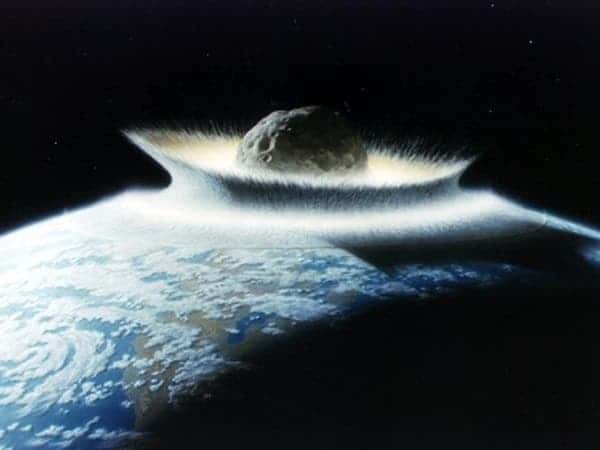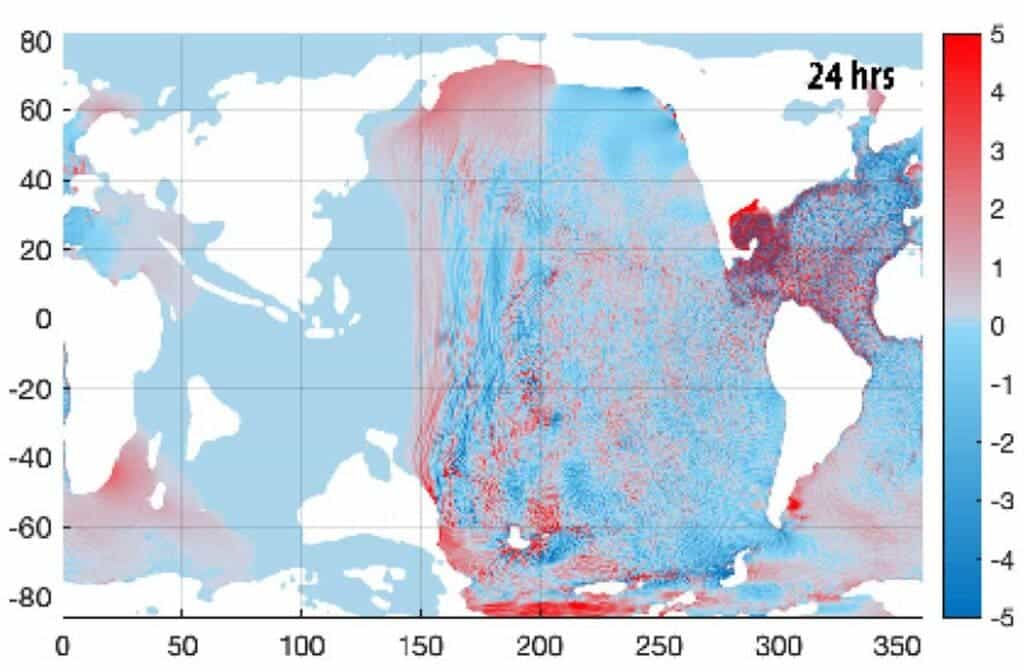
The asteroid that struck Earth offshore Mexico’s Yucatan Peninsula was simply devastating to all life on Earth, not just the dinosaurs. The cosmic impact unleashed the force of 10 billion Hiroshima A-bombs and ejected gigatons of sulfur and carbon dioxide into the atmosphere, which could have lowered surface air temperatures by a staggering 26 degrees Celsius (47 degrees Fahrenheit). This global winter lasted for years, enough to devastate plant life and everything else along the food chain. Around 75% of all animals and plant species went extinct, including the iconic dinosaurs (except for birds).
But it wasn’t just the blast and subsequent famine that wreaked havoc. In the immediate aftermath of the cosmic impact, a monstrous tsunami was triggered. Its waves went as high as a mile and ravaged the ocean floor for many thousands of miles from the impact site. In a new study, scientists have now conducted the first global simulation of the Chicxulub tsunami, which reveals new insights about the path and power these enormous waves took.
“This tsunami was strong enough to disturb and erode sediments in ocean basins halfway around the globe, leaving either a gap in the sedimentary records or a jumble of older sediments,” said lead author Molly Range from the University of Michigan, who conducted the research as part of the master’s thesis.
The ripples of an ancient giant tsunami
Range and colleagues, including physical oceanographer Brian Arbic and paleoceanographer Ted Moore, combed through the geological record from more than 100 sites across the world. Specifically, they looked at the K–Pg boundary, a thin layer of sediment deposited just after the asteroid impact that marks the end of the Cretaceous period and is about 66 million years old.
These sites showed disturbances in the uppermost Cretaceous marine sediments that are consistent with the results outputted by the researchers’ simulation, giving confidence that the model is a good approximation of the chain of events that unfolded as a result of the asteroid impact. Based on previous studies, the researchers estimated that the killer asteroid was around 14 kilometers in diameter (8.7 miles) and struck the granite crust of Yucatan at 43,500 km/h (27,000 mph), forming a massive 100-kilometer-wide (62-mile-wide) crater.

Researchers estimated that the energy of the initial impact tsunami was up to 30,000 times higher than that of the 2004 Indian Ocean earthquake tsunami, one of the deadliest disasters in modern history. The Indian Ocean tsunami hit the coasts of several countries of South and Southeast Asia, killing over 230,000 people and displacing millions. The 9.1 quake from 2004 ruptured a 900-mile stretch of fault line where the Indian and Australian tectonic plates meet, triggering 30-meter-high waves. That is totally devastating, but now imagine the destruction caused by the Chicxulub tsunami, whose waves were up to 1,600 meters high just ten minutes after the projectile hit and up to 4,500 meters high two and a half minutes after impact.
From the Yucatan Peninsula, the tsunami radiated mainly to the east and northeast, causing the most damage in the North Atlantic Ocean, as well as to the southwest through the Central American Seaway, which used to separate North America and South America, into the South Pacific Ocean. The South Atlantic, the North Pacific, the Indian Ocean, and the region that is today the Mediterranean were largely spared by the strongest waves of the tsunami.
One hour after the impact, the tsunami was already spreading into the North Atlantic. Twenty-four hours in, the waves had traversed most of the Pacific from the east and most of the Atlantic from the west. By the 48-hour mark, the tsunami had reached virtually every coastline of the Late Cretaceous world. For instance, the researchers identified heavily disturbed marine sediments in New Zealand more than 12,000 kilometers (7,500 miles) from the Yucatan impact site. Previously, these disturbances to sedimental deposits were thought to have been caused by tectonic activity, but their age and location in the path of the modeled Chicxulub impact tsunami suggest a different origin.
“We feel these deposits are recording the effects of the impact tsunami, and this is perhaps the most telling confirmation of the global significance of this event,” Range said.
“Depending on the geometries of the coast and the advancing waves, most coastal regions would be inundated and eroded to some extent,” according to the study authors. “Any historically documented tsunamis pale in comparison with such global impact.”


